-
IP addresses are NOT logged in this forum so there's no point asking. Please note that this forum is full of homophobes, racists, lunatics, schizophrenics & absolute nut jobs with a smattering of geniuses, Chinese chauvinists, Moderate Muslims and last but not least a couple of "know-it-alls" constantly sprouting their dubious wisdom. If you believe that content generated by unsavory characters might cause you offense PLEASE LEAVE NOW! Sammyboy Admin and Staff are not responsible for your hurt feelings should you choose to read any of the content here. The OTHER forum is HERE so please stop asking.
You are using an out of date browser. It may not display this or other websites correctly.
You should upgrade or use an alternative browser.
You should upgrade or use an alternative browser.
Chinese fleeing COVID-19 in China overwhelming SG's hospital infrastructure and resources
- Thread starter LITTLEREDDOT
- Start date
See how State Times and western media all ways criticize China for zero covid. Now xi reversed course they criticized the CCP again. Truly nothing can please these publicists for the globalist cabal.
dey never bot anyting from faizer ... so foul chee cant stop eff dem ...
Chinese demand for travel jumps as Beijing opens the floodgates
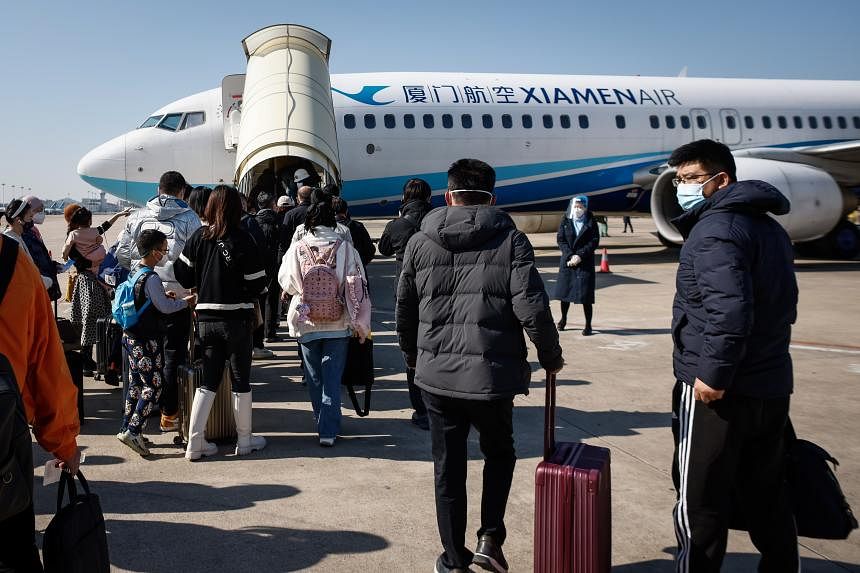
Passengers bound for Beijing board an airplane at the Xiamen Gaoqi International Airport in Fujian province on Dec 26, 2022. PHOTO: EPA-EFE
DEC 28, 2022
BEIJING – A surge in holiday bookings shows China’s vast population is ready and hungry for travel as the country dismantles border controls and emerges from nearly three years of self-imposed isolation.
After the announcement that travellers will not be subject to quarantine from Jan 8 onwards, bookings for outbound flights from mainland China jumped 254 per cent on Tuesday morning from the day before, according to Trip.com Group Ltd. data.
The top five destinations were Singapore, with a 600 per cent increase in bookings, followed by about 400 per cent for South Korea, Hong Kong, Japan and Thailand.
China’s Covid Zero policy effectively stopped overseas leisure trips throughout the pandemic, with people urged to stay in the country “unless absolutely necessary” for work, study or compassionate reasons. Travel visas to Hong Kong have not been issued since early 2020 and authorities stopped granting new passports in August 2021 for any unnecessary and non-urgent reasons.
China is now preparing to issue new passports and Hong Kong permits again, and opening the floodgates to three years of pent-up travel demand. Within half an hour of the government’s reopening policy announcement, searches for overseas destinations shot up by 1,000 per cent, hitting a three-year high, according to Trip.com. Macau and Hong Kong were among the top searches.
The week-long Lunar New Year holiday at the end of January presents a good opportunity to fly overseas – searches related to travel packages during the break climbed 600 per cent.
It will still take time for Chinese tourist numbers to return to pre-pandemic levels, when they made up the largest group and were some of the biggest spenders. Japan requires a negative Covid-19 test upon arrival for travellers from China, while Malaysia has imposed new tracking and surveillance measures. The United States is weighing similar steps due to mounting concerns over renewed risk of infections as China battles Covid-19 – almost 37 million people in the country may have been infected with the virus on a single day last week, according to estimates from the government’s top health authority.
High air fares could also keep a lid on travel, according to some of the responses to a poll on Weibo, which is similar to Twitter.
Demand for travel into China is rising too. Bookings for inbound flights to mainland China increased by 412 per cent on Tuesday morning from a day earlier, according to Trip.com data. Many of the Chinese diaspora across the globe – including overseas students – have been kept out due to strict quarantine requirements and haven’t seen family and friends in years.
“I’ve waited so long for this day,” an overseas student wrote on Weibo. “Finally getting to go home!” BLOOMBERG
China to drop Covid-19 tests for inbound travellers from Jan 8
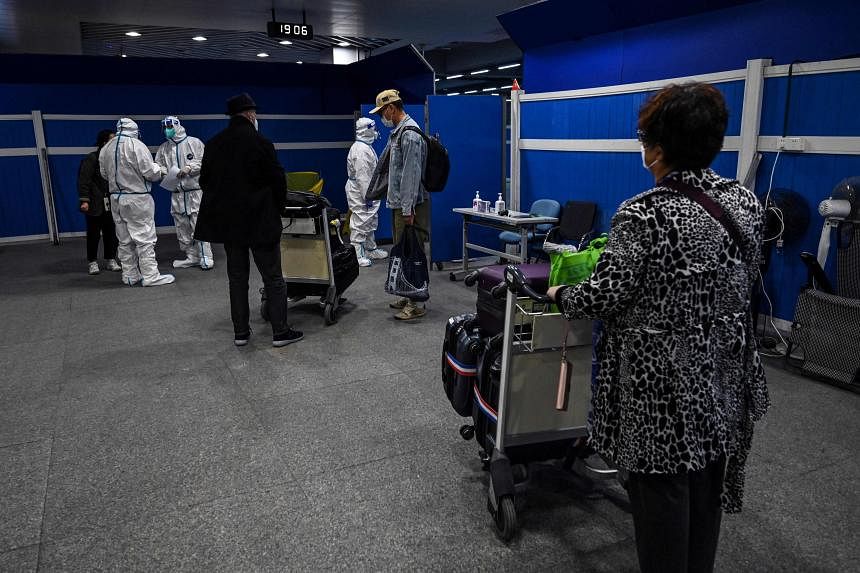
China’s management of Covid-19 is set to be downgraded to the less strict Category B from the top-level Category A from Jan 8. PHOTO: AFP
DEC 28, 2022
BEIJING - China will drop a requirement for inbound travellers to take Covid-19 polymerase chain reaction (PCR) tests starting from Jan 8, 2023, customs authorities said on Wednesday.
PCR checks for imported chilled and frozen foods will also be dropped, China’s General Administration of Customs said.
China’s management of Covid-19 is set to be downgraded to the less strict Category B from the top-level Category A from Jan 8, the health authority said on Monday.
The civil aviation authority also said on Wednesday that China will gradually resume accepting applications for international passenger charter flights from Chinese and foreign airlines.
China will also fully restore pre-pandemic flight procedures and requirements by the summer and autumn season in 2023, it added. REUTERS
Italy imposes mandatory Covid-19 tests for travellers from China
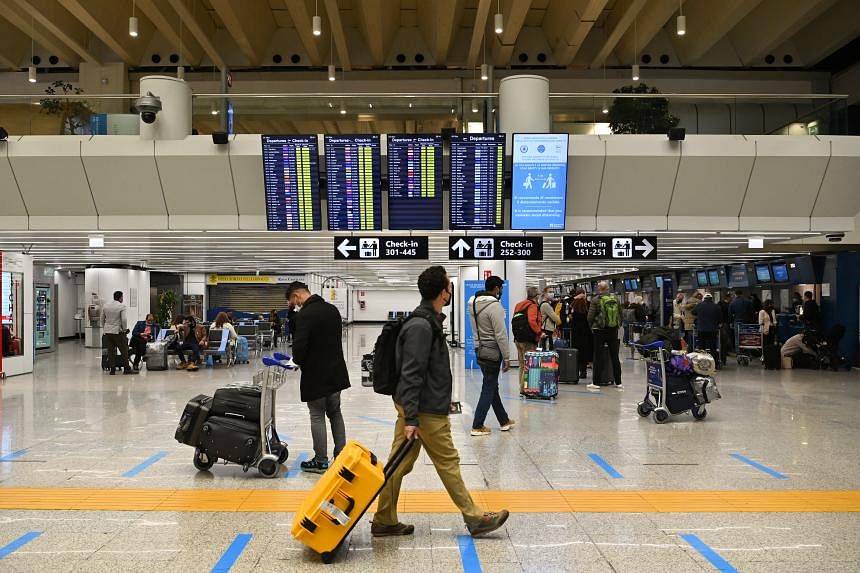
All passengers coming from China and transiting through Italy will have to undergo the mandatory Covid-19 tests. PHOTO: ST FILE
DEC 29, 2022
ROME - Italy said on Wednesday it is imposing mandatory Covid-19 tests for travellers arriving from China, following an explosion in cases there.
“I have ordered mandatory Covid-19 antigenic swabs, and related virus sequencing, for all passengers coming from China and transiting through Italy,” Health Minister Orazio Schillaci said.
“The measure is essential to ensure surveillance and detection of possible variants of the virus in order to protect the Italian population,” Mr Schillaci said.
He added that he would report in detail to the Cabinet at a meeting later on Wednesday.
The northern Lombardy region had already introduced such screenings ahead of Wednesday’s announcement.
Milan health authorities said on Wednesday that almost half of the passengers on two flights from China tested positive for Covid-19.
Milan’s region health chief said at a press conference on Wednesday that airport authorities tested passengers who arrived on two flights, one from Beijing and one from Shanghai.
On the first flight to Malpensa that tested passengers from China, out of 62 passengers, 35 were Covid positive, Lombardy’s health chief Guido Bertolaso said on Wednesday. On the second, 62 were positive out of 120.
Italy is now sequencing those tests to see if there are new variants coming from China, the Health Ministry said in a statement.
If a new strain is found, officials may impose stricter curbs on travel from China.
The minister did not say what measures would be imposed on travellers testing positive, but the local health chiefs in the Lombardy region around Milan and the Lazio region around Rome said they would have to quarantine in buildings set aside by the local health authorities.
Lombardy was the first region to impose a lockdown when coronavirus hit Europe in early 2020.
It is now testing arrivals from China at Milan’s Malpensa airport at least until Jan 30, the foreign ministry said.
While the high rate of passengers with the virus has put authorities on alert, one factor in Italy’s favour is its high vaccination rate.
More than 80 per cent of people are fully inoculated, according to the Word Health Organisation, and many have also received booster shots. It’s a similar story across much of Western Europe.
Coronavirus infections have surged in China as it unwinds strict controls that had adversely affected the economy and sparked nationwide protests. AFP, REUTERS, BLOOMBERG
China’s Covid-19 surge leads countries, territories to consider entry restrictions
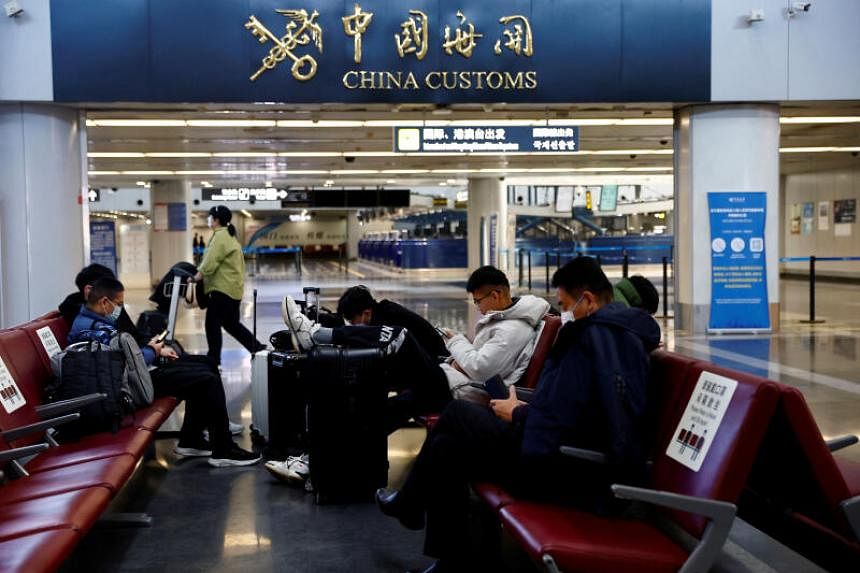
China is experiencing the world’s largest Covid-19 outbreak, raising concerns among public-health officials worldwide. PHOTO: REUTERS
Dec 29, 2022
NEW YORK – Nations across the globe are implementing or considering measures to test or restrict travellers from China as the country of 1.4 billion abandons its zero-Covid policy and prepares to reopen borders in early January.
The US is considering new coronavirus precautions for people travelling from China amid questions about the transparency of data China is reporting about the spread of the virus, according to American officials, who asked not to be identified.
Japan moved quickly yesterday to announce steps requiring a negative Covid-19 test upon arrival soon after Beijing said it no longer subject inbound travellers to quarantine from Jan 8.
China is rapidly dismantling its stringent pandemic measures in the face of discontent with zero-Covid rules, triggering outbreaks across the country.
Uncertainty over the true scale of infections without reliable official figures is fuelling concern that the rapid spread of the virus could lead to the emergence of new variants.
China is experiencing the world’s largest Covid-19 outbreak, raising concerns among public-health officials worldwide.
Almost 37 million people may have been infected with the virus on a single day last week, according to estimates from the government’s top health authority.
Earlier this week, Japanese Prime Minister Fumio Kishida said there are “great discrepancies” in information coming out of the country, fuelling growing concern.Japan will require negative Covid-19 test results upon arrival for visitors who have been in mainland China within a seven-day period, while those who test positive will have to quarantine for a week.
The US is weighing similar steps, the officials said, as a way to prevent further spread.
India began random testing of about 2 per cent of passengers arriving from other countries at all international airports a week ago to minimise the risk of any new variant entering the country.
Holiday bookings for outbound flights from mainland China jumped 254 per cent Tuesday morning from the day before, according to Trip.com Group data, underscoring how the country’s vast population is ready and hungry for travel.
The top five destinations were Singapore, with a 600 per cent increase in bookings, followed by about 400 per cent for South Korea, Hong Kong, Japan and Thailand.
China will start issuing new passports and Hong Kong travel permits to mainland residents, the National Immigration Administration said in an announcement on WeChat late on Monday. Express checkpoints on the borders with Hong Kong and Macau will resume, while applications by foreigners to extend or renew visas will also re-commence as part of the relaxation of measures on Jan 8.
Taiwan may also adjust Covid-19 measures such as testing as it anticipates tens of thousands of people returning from the Chinese mainland for the Chinese New Year later in January, Cabinet spokesman Lo Ping-cheng said in a statement. While Taiwan currently does not allow mainland Chinese tourists to get in, many Taiwanese work and invest in the mainland.
Philippine Transport Secretary Jaime Bautista called for Covid-19 measures on Wednesday, including testing on inbound travellers from China. “We should be very cautious because if they have a lot of Covid cases, we should be careful about Chinese visitors coming into the Philippines,” he told reporters.
But some countries are unfazed by China’s Covid-19 outbreak.
Indonesia’s President Joko Widodo has said that he is not worried about a possible surge of Covid-19 infection caused by foreign tourists.
“As long as our serosurvey shows results above 90 per cent, which means we already have proper immunity, then whatever comes our way won’t be a problem,” said the Mr Widodo, in response to questions on how the government plans to anticipate the rise of Covid-19 infections in China.
Thailand’s Tourism Authority of Thailand (TAT) said it is working with its five offices in China – in Beijing, Shanghai, Guangzhou, Kunming and Chengdu – to revise its plan to attract Chinese tourists to Thailand.
“Chinese travel agencies have launched travel packages to Thailand for the upcoming Chinese New Year festival,” said TAT executive director of the East Asia region, Mr Chuwit Sirivejkul.
Visitors from China were Thailand’s largest tourism market before the pandemic struck in 2020.
Thai Tourism and Sports Minister Phiphat Ratchakitprakarn said Thailand would increase next year’s target for international tourists, from 20 million to 25 million, following Beijing’s announcement. This will help the country reach its 2023 tourism revenue target of 2.38 trillion baht (S$92 billion), the minister said.
In Germany, a government official said the country currently sees no need to impose new travel restrictions for people coming from China.
“We are monitoring the situation in China very closely, but at the moment we have no indication that a more dangerous mutation has developed... which would justify the declaration of a virus variant zone,” a health ministry spokesperson said.
Such a status requires anyone entering Germany to quarantine for two weeks on arrival.
The new US travel precautions are based on consultations with public health experts and international partners, officials said. They said the talks have been prompted in part by concerns over the lack of genomic sequencing data that could help identify the emergence of a new variant.
Health experts have said they’re worried that the virus’s unabated spread could spawn a dangerous new variant for the first time since the Omicron strain caused infections to surge more than a year ago.
GISAID, the global consortium that maintains a database for scientists around the world to share coronavirus sequences to monitor mutations, said on Tuesday that China has ramped up its surveillance amid the ongoing outbreak.
All the sequences shared by the Chinese health authorities suggest the viruses fuelling the massive nationwide outbreak closely resemble the circulating variants found in the rest of the world since July, they added. BLOOMBERG, THE JAKARTA POST, THE NATION/ASIA NEWS NETWORK
Soaring China Covid-19 cases increase risk of new, lethal variants
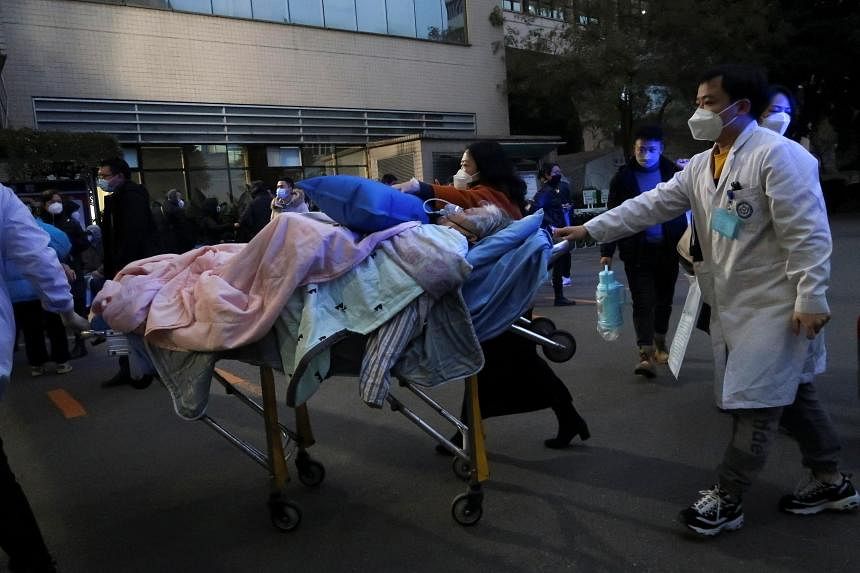
Officials in several cities estimate that hundreds of thousands of people have been infected in recent weeks. PHOTO: REUTERS
Dec 29, 2022
PARIS – An explosion of Covid-19 cases in China as the country lifts its zero-Covid measures could create a “potential breeding ground” for new variants to emerge, health experts warn.
China has announced that incoming travellers would no longer have to quarantine from Jan 8, the latest major reversal of strict restrictions that have kept the country largely closed off to the world since the start of the pandemic.
While the country’s National Health Commission has stopped issuing daily case numbers, officials in several cities estimate that hundreds of thousands of people have been infected in recent weeks. Hospitals and crematoriums have been overwhelmed across China.
With the virus now able to circulate among nearly one-fifth of the world’s population – almost all of whom lack immunity from previous infection and many of whom remain unvaccinated – other nations and experts fear China will become fertile ground for new variants.
Dr Antoine Flahault, director of the Institute of Global Health at the University of Geneva, said each new infection increased the chance the virus would mutate.
“The fact that 1.4 billion people are suddenly exposed to SARS-CoV-2 obviously creates conditions prone to emerging variants,” Dr Flahault said, referring to the virus that causes the Covid-19 disease.
Dr Bruno Lina, a virology professor at France’s Lyon University, told the La Croix newspaper this week that China could become a “potential breeding ground for the virus”.
Dr Soumya Swaminathan, who served as the World Health Organisation’s chief scientist until November, said a large part of the Chinese population was vulnerable to infection in part because many elderly people had not been vaccinated or boosted.“We need to keep a close watch on any emerging concerning variants,” she told the website of the Indian Express newspaper.
Countries test Chinese travellers
In response to the surging cases, the United States, Italy, Japan, India and Malaysia announced this week they would increase health measures for travellers from China.The lack of transparent data from China – particularly about viral genomic sequencing – is making it “increasingly difficult for public health officials to ensure that they will be able to identify any potential new variants and take prompt measures to reduce the spread”, US officials said on Tuesday.
India and Japan have already said they will impose mandatory PCR testing on all passengers from China, a measure Dr Flahault said could be a way around any delays in information from Beijing.
“If we succeed to sample and sequence all viruses identified from any travellers coming in from China, we will know almost as soon as new variants emerge and spread” in the country, he said.
Variant ‘soup’
Dr Xu Wenbo, head of the virus control institute at China’s Centre for Disease Control and Prevention, said last week that hospitals across China would collect samples from patients and upload the sequencing information to a new national database, allowing the authorities to monitor possible new strains in real-time.More than 130 Omicron sublineages have been newly detected in China over the last three months, he told journalists.
Among those were XXB and BQ.1 and their sublineages, which have been spreading in the US and parts of Europe in recent months as a swarm of subvariants has competed for dominance worldwide.
However, BA.5.2 and BF.7 remain the main Omicron strains detected in China, Dr Xu said, adding that the varying sublineages would likely circulate together.
Dr Flahault said “a soup” of more than 500 new Omicron subvariants has been identified in recent months, although it has often been difficult to tell where each first emerged.
“Any variants, when more transmissible than the previous dominant ones – such as BQ.1, B2.75.2, XBB, CH.1, or BF.7 – definitely represent threats, since they can cause new waves,” he said.
“However, none of these known variants seems to exhibit any particular new risks of more severe symptoms to our knowledge, although that might happen with new variants in the coming future.” AFP
‘Rebound with a vengeance’: Asia’s tourist hot spots prepare for boom as China relaxes Covid-19 rules
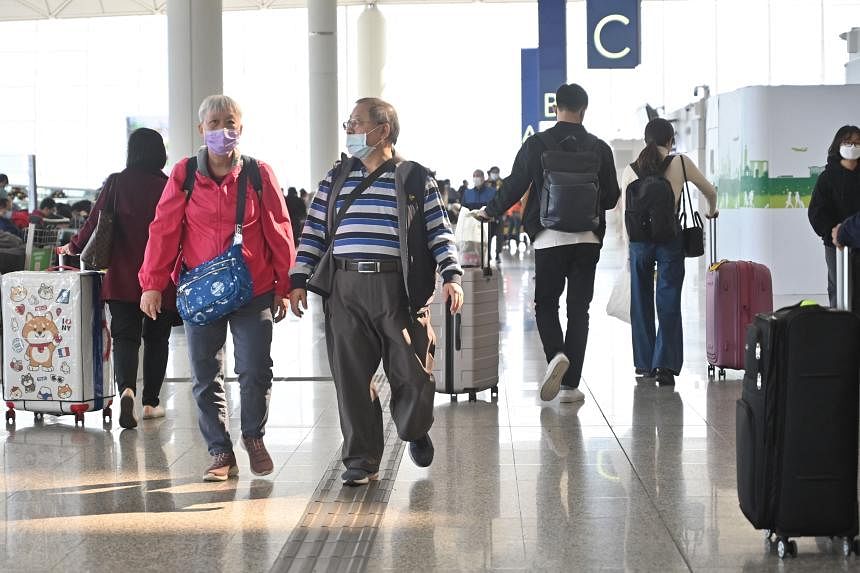
Chinese tourists will no longer need to quarantine when they return home starting Jan 8, 2022. PHOTO: AFP
Dec 29, 2022
BANGKOK/SINGAPORE/SYDNEY - Asian countries are bracing for an influx of Chinese tourists as Covid-19 restrictions are dismantled, and while some are wary, operators in others are preparing packages such as hotpot buffets to cash in on the expected spike in travel.
Chinese tourists will no longer need to quarantine when they return home starting Jan 8, the government announced this week, a move that spurred a surge in bookings from what was the world’s largest outbound travel market in 2019.
The once US$255 billion (S$344 billion) a year in global spending by Chinese tourists ground to a virtual halt during the pandemic, leaving a gaping hole in the Asian market, where countries from Thailand to Japan had depended on China as the largest source of foreign visitors.
International flights to and from China are at just 8 per cent of pre-pandemic levels, VariFlight data shows, but carriers are looking to ramp up capacity as authorities ease Covid-driven limits on the number of flights.
“There is little doubt mainland Chinese are the spark plug for Thailand’s tourism recovery,” said Mr Bill Barnett, managing director of hospitality consultancy C9 Hotelworks. “It’s not a question of if it will happen, it’s now just a matter of how many and how fast.”
Malaysia Airlines and Vietnamese budget carrier VietJet Aviation said they hope to restore China flights to pre-pandemic levels by June 2023, while others such as Singapore Airlines and Australia’s Qantas Airways declined to provide detailed targets as the situation evolves.
Chinese airlines are likely to make significant increases to capacity from the end of March, coinciding with the start of the summer scheduling season, Morningstar analyst Cheng Weng told clients in a note.
Rebound with a vengeance
The prospect of cash-rich Chinese flocking to shopping streets across the world boosted luxury stocks this week, as China accounts for 21 per cent of the world’s 350 billion euro (S$501 billion) luxury goods market.
As the Lunar New Year holiday - typically a peak travel period for Chinese tourists - starts on Jan 21, some businesses are already gearing up.
Sofitel Sentosa in Singapore is creating Lunar New Year packages aimed at Chinese visitors, including a hotpot buffet and romantic packages for couples, said Mr Cavaliere Giovanni Viterale, general manager of that hotel and the upcoming Raffles Sentosa, as the company bets that a travel rebound will come “with a vengeance”.
In Japan, tour bus firm Hato Bus says next month it will try out Chinese-language tours it had halted during the pandemic, with the aim of a full resumption by the spring, a spokesman said.
Japan, however, is being cautious about Chinese tourism due to the rapid spread of the virus in China. It is requiring a negative Covid-19 test on arrival from Chinese visitors, and those who test positive must quarantine for seven days under new border measures taking effect on Dec 30.
The United States said it would impose mandatory Covid-19 tests on travellers from China, joining India, Italy and Taiwan in taking new measures, while the Philippines is considering a testing requirement.
Australia, Germany, Thailand and others, however, said they would not impose additional rules on Chinese travel for now, with France taking to social media platform Sina Weibo to emphasise it welcomed Chinese friends “with open arms”.
In Vietnam, where tourist visas for Chinese are not yet being issued, Saigon Halong Hotel in Halong Bay expects it will receive Chinese arrivals from the second quarter of next year.
Any hopes of a massive rebound in Chinese travel to Australia during the Lunar New Year holiday are probably misplaced, Mr James Shen, general manager of Melbourne-based tour agency Odyssey Travel said, citing sky-high airfares.
“There are still very few flights and they would be booking very last minute,” he said. “I suspect any meaningful rebound will have to wait until the travel boom in June or July next year.” REUTERS
US to impose Covid-19 testing for travellers from China from Jan 5
Dec 29, 2022WASHINGTON - The United States will require airline passengers coming from China to show negative Covid-19 tests as global concerns over the virus’ spread ratchet higher since the country lifted restrictions aimed at stamping out infections.
Citing the need to protect Americans’ health, the US Centres for Disease Control and Prevention announced that from Jan 5, all air travellers originating in China will have to provide a new negative Covid-19 test to airlines before they depart.
“The recent rapid increase in Covid-19 transmission in China increases the potential for new variants emerging,” a senior US health official told reporters in a phone briefing.
However, the official said, Beijing has provided only limited data about circulating variants in China to global databases, and its testing and reporting on new cases has also diminished.
US health experts are particularly concerned about the emergence of new variants that might not be picked up in testing in China. Health officials said they will continue to press China to release data and genome sequences of the virus.
Travellers coming directly from China or who were in the country 10 days before their departure to the US will have to show either a negative PCR or antigen test for the coronavirus.
The requirement applies to all passengers regardless of nationality or vaccination status and will go into effect from Jan 5 at 12.01am New York time.
Passengers who tested positive more than 10 days before travelling can provide documentation and recovery from Covid-19 in lieu of a negative test result, federal health officials said. Airlines will need to confirm the negative Covid-19 test or documentation of recovery prior to boarding flights to the US. The requirement also applies to travellers from Hong Kong and Macau.The US move came after Italy, Japan, India and Malaysia announced their own measures to protect against importing new Covid-19 variants from China.
Taiwan, a self-ruled island that China claims as its own, also said on Wednesday that it would also screen travellers from the mainland for the virus.
Meanwhile, Mr Dirk De fauw, mayor of Bruges, Belgium, which is popular with Chinese tourists, called for Chinese visitors to face Covid-19 tests or mandatory vaccine requirements, the Belga news agency reported.
“The infection rate is still very high. I think we have to work either with a vaccination certificate or with tests,” said Mr De fauw.
In the US, Covid-19 testing at airports has tapered off as countries have abandoned pandemic-era travel restrictions. However, US health officials said that voluntary testing and sequencing at airports has continued and will be further expanded under a new effort to ramp up precautions amid the outbreak in China.
The US CDC will expand its viral genomic surveillance programme of travellers to two additional airports, bringing the total number of airports collecting samples for sequencing to seven. Passengers boarding hundreds of flights from at least 30 countries are covered by the programme.
Covid-19 has been spreading unabated in China since the government lifted its policy of strict quarantines and isolation for exposed and infected people. Almost 37 million people may have been infected with the virus on a single day last week, according to estimates from the Chinese government’s top health authority.
For the past three years, Chinese officials have adhered to stringent rules around testing and quarantines that were often subject to international criticism. Earlier in December, after widespread protests against the restrictive policies, Chinese officials abruptly announced lifting of the restrictive policies without a plan for simultaneously boosting vaccination coverage.
That has allowed the virus to spread rapidly, filling healthcare facilities with sick patients, most without immunity from vaccination or prior infection like the majority of people in other countries.
China’s Centre for Disease Prevention and Control reported 5,231 new Covid-19 cases and three deaths nationwide on Wednesday – likely a drastic undercount since people are no longer required to declare infections to authorities.
“Currently the development of China’s epidemic situation is overall predictable and under control,” foreign ministry spokesman Wang Wenbin said on Wednesday.
“Hyping, smearing and political manipulation with ulterior motives can’t stand the test of facts,” Mr Wang added, calling Western media reporting on the Covid-19 surge “completely biased”. BLOOMBERG, AFP
Around the world: Covid-19 rules for travellers from China
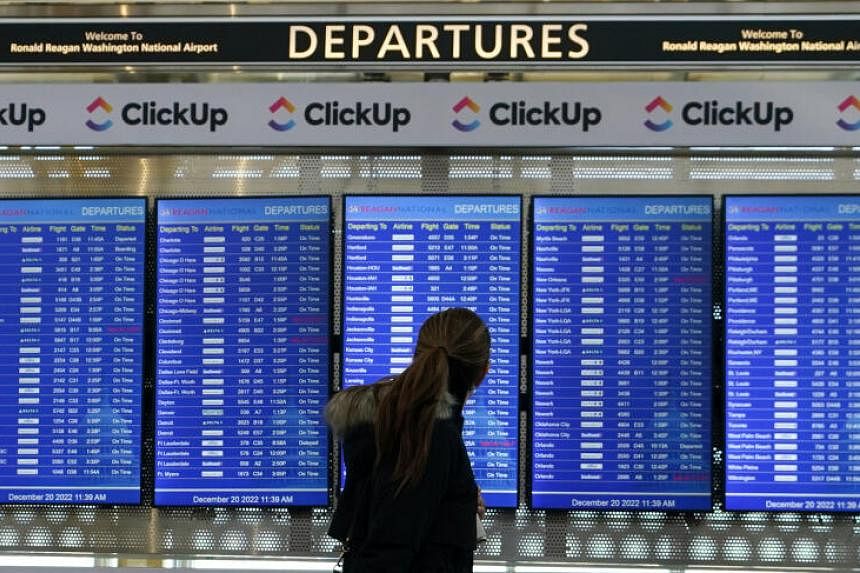
The US will impose mandatory Covid-19 tests on travellers from China beginning on Jan 5. PHOTO: REUTERS
Dec 29, 2022
BEIJING - Several places around the world have imposed curbs on travellers from China amid a Covid-19 surge after Beijing relaxed strict zero-Covid measures. They cite a lack of information from China on variants and are concerned about a wave of infections.
China has rejected criticism of its statistics and said it expects future mutations to be potentially more virulent but less severe.
Below is a list of rules for travellers from China:
United States
The US will impose mandatory Covid-19 tests on travellers from China beginning on Jan 5. All air passengers 2 and older will require a negative result from a test no more than two days before departure from China, Hong Kong or Macau. The Centres for Disease Control and Prevention also said Americans should also reconsider travel to China, Hong Kong and Macau.India
India will make a Covid-19 negative test mandatory for flyers from China, Hong Kong, Japan, South Korea, Singapore and Thailand from Jan 1, the health minister said on Thursday. Travellers from these places would have to upload their test reports on an India government website before their departure, minister Mansukh Mandaviya wrote on Twitter.Japan
Japan will require a negative Covid-19 test upon arrival for travellers from mainland China. Those who test positive will be required to quarantine for seven days. New border measures for China will go into effect at midnight on Dec 30. The government will also limit requests from airlines to increase flights to China. Hong Kong’s government has asked Japan to withdraw a restriction that requires passenger flights from the financial hub to land at four designated Japanese airports, saying the decision will affect about 60,000 passengers.Italy
The country has ordered Covid-19 antigen swabs and virus sequencing for all travellers coming from China. Milan’s main airport, Malpensa, had already started testing passengers arriving from Beijing and Shanghai. “The measure is essential to ensure surveillance and detection of possible variants of the virus in order to protect the Italian population”, minister Orazio Schillaci said, when announcing mandatory testing for passengers.Taiwan
Taiwan’s Central Epidemic Command Centre said all passengers arriving on direct flights from China, as well as by boat at two offshore islands, will have to take PCR tests upon arrival. Taiwan will test arrivals from China for Covid-19 starting Jan 1.Singapore
Singapore will keep its prevailing Covid-19 rules in place for incoming travellers from China. Those who are not fully vaccinated, based on the World Health Organisation’s definition, will need to undergo pre-departure tests before they can enter the country, the Ministry of Health (MOH) said. Short-term visitors are also required to buy insurance for Covid-19-related medical expenses.Countries considering travel curbs
UK
The UK will consider imposing Covid-19 restrictions for arrivals from China, including requiring tests for the coronavirus, the Telegraph reported. Officials from the Department for Transport, Home Office and the Department for Health and Social Care are expected to decide on Thursday whether the UK should follow the US and Italy in imposing Covid-19 restrictions for travellers from China, the report said.Countries monitoring situation
Australia
The country said it was making no change to its rules around allowing travellers from China in. “There is no change in the travel advice at this point in time but we are continuing to monitor the situation, as we continue to monitor the impact of Covid-19 here in Australia as well as around the world,” Prime Minister Anthony Albanese said.Germany
In Germany, Mr Sebastian Gülde, a health ministry official said the country currently sees no need to impose new travel restrictions for people coming from China. “We are monitoring the situation in China very closely, but at the moment we have no indication that a more dangerous mutation has developed... which would justify the declaration of a virus variant zone.” Such a status requires anyone entering Germany to quarantine for two weeks on arrival.France
Prof Brigitte Autran, head of the French health risk assessment committee COVARS said that from a scientific point of view, there is no reason to bring back controls at the border. But that could change any day, she added. Prof Autran - who advises the government on epidemiological risks - said on French Radio Classique that for now “the situation is under control” and that there are no signs of worrying new Covid-19 variants in China.Philippines
The Philippines’ Department of Health doesn’t see a need yet to close borders or impose tighter Covid restrictions on inbound Chinese travellers, the agency’s officer-in-charge Maria Rosario Vergeire said. The agency is confident that existing health protocols are sufficient, Ms Vergeire said at a briefing on Thursday. “We can’t just have closures, then open it, then close it again. We are moving forward,” she said. REUTERS, BLOOMBERGEurope seeks joint stance on Covid-19 measures towards China
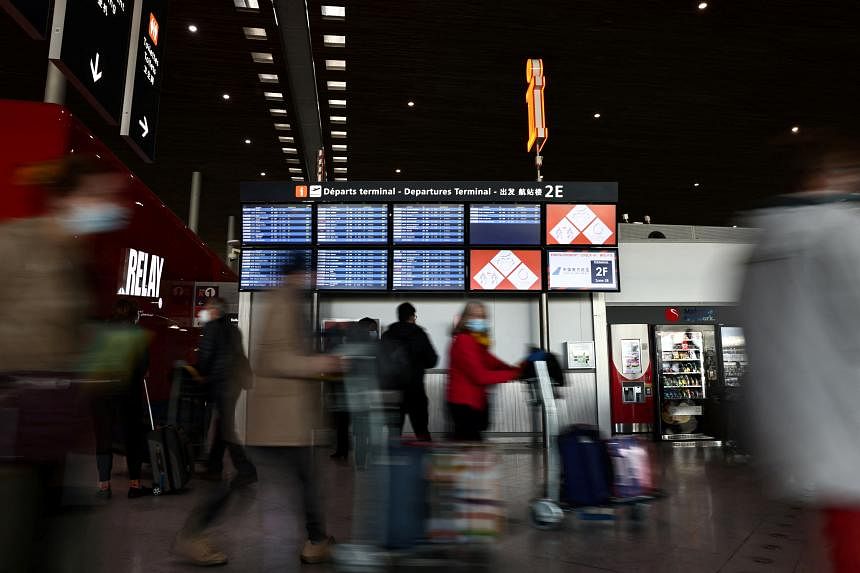
The scale of the outbreak in China and doubts over official data have prompted countries to impose new travel rules on Chinese visitors. PHOTO: REUTERS
Dec 29, 2022
BRUSSELS/PARIS - Top health officials from the European Union are holding talks on Thursday to try to coordinate very different views on how to respond to China’s decision to lift its Covid-19 restrictions amid a wave of infections there.
The scale of the outbreak in China and doubts over official data have prompted countries including the United States, India, and Japan to impose new travel rules on Chinese visitors.
In the EU, only Italy has done so, while others in the largely borderless bloc either said they see no need to follow suit or are waiting for a common stance across the 27 member states.
“From a scientific point of view, there is no reason at this stage to bring back controls at the borders,” Brigitte Autran, head of the French health risk assessment committee Covars, said on French Radio Classique.
Ms Autran, who advises the government on epidemiological risks, said that could change at any time but that for now the situation is under control and there are no signs of worrying new Covid-19 variants in China.
Germany on Wednesday said it saw no need to impose new travel restrictions, and Austria stressed the economic benefits of the prospects of seeing a return of Chinese tourists to Europe.
In Britain, a government spokesperson said on Thursday there is no plan to bring back Covid-19 testing for those coming into the country.
In Italy, however, Deputy Prime Minister and Transport Minister Matteo Salvini said in a Twitter post on Wednesday that “Italy cannot be the only country to carry out anti-Covid checks at airports for those arriving from China”.
“I have asked that checks and possible limitations be applied throughout Europe.”
Prime Minister Giorgia Meloni may say more on this in her end-of-year news conference from around 11.30am local time.
The main airport in the Italian city of Milan started testing passengers arriving from Beijing and Shanghai on Dec 26 and found that almost half of them were infected.
It is unclear when the EU health committee, which started its meeting on Thursday morning, would end and what decisions it could take.
“The EU Health Security Committee is meeting ... to discuss the Covid-19 situation in China and possible measures to be taken in a coordinated way,” the European Commission’s health directorate general said on Twitter.
The Health Security Committee is composed of officials from health ministries across the bloc and chaired by the Commission.
It has met frequently at the height of the Covid-19 pandemic in Europe to coordinate policies.
Any decision would only be advisory, but its aim is for member states to agree a common line and apply it across the bloc. REUTERS
India makes Covid-19 test mandatory for travellers from 6 locations including Singapore
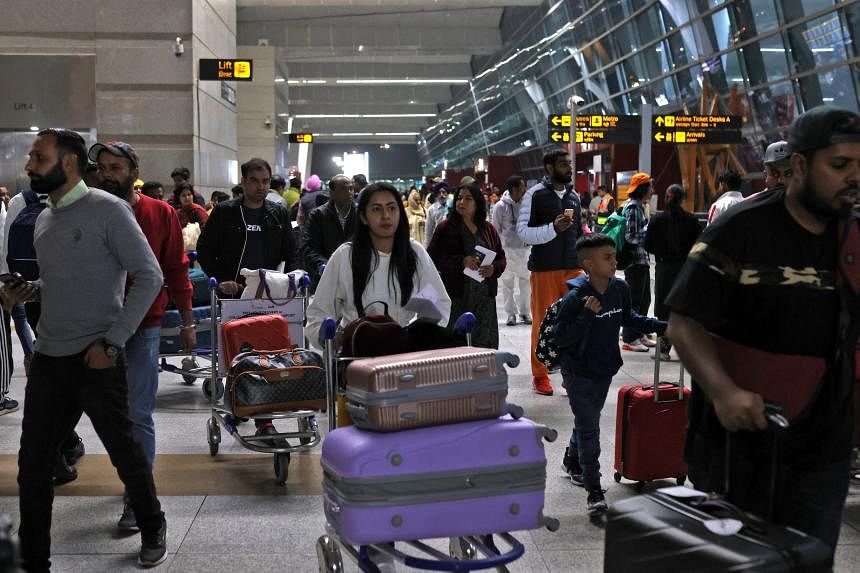
Travellers would have to upload their test reports on an India government website before their departure. PHOTO: REUTERS
Dec 29, 2022
NEW DELHI - India will make a Covid-19 negative test mandatory for travellers from China, Hong Kong, Japan, South Korea, Singapore and Thailand from Jan 1, the health minister said on Thursday.
Travellers from these places would have to upload their test reports on an India government website before their departure, minister Mansukh Mandaviya wrote on Twitter.
“This is being done in view of the evolving Covid-19 situation across the world, particularly in the aforesaid countries,” the health ministry said in a statement.
It added that the test should be taken within 72 hours of travel to India.
The new requirement for a Covid-19 test would be in addition to the random tests on 2 per cent of all international passengers arriving in India.
India on Thursday reported 268 new Covid-19 cases, the highest since Dec 2, according to data from the federal health ministry.
The country joins the United States, Japan, Italy and Taiwan in imposing mandatory Covid-19 tests for travellers from China, amid a Covid-19 surge there after authorities relaxed strict “zero-Covid” rules.
Top health officials from the European Union are holding talks on Thursday to try to coordinate very different views on how to respond to China’s decision to lift its Covid-19 restrictions amid a wave of infections there. BLOOMBERG, REUTERS
No new variant has emerged from China’s Covid-19 outbreak, but it may be a matter of time: Experts
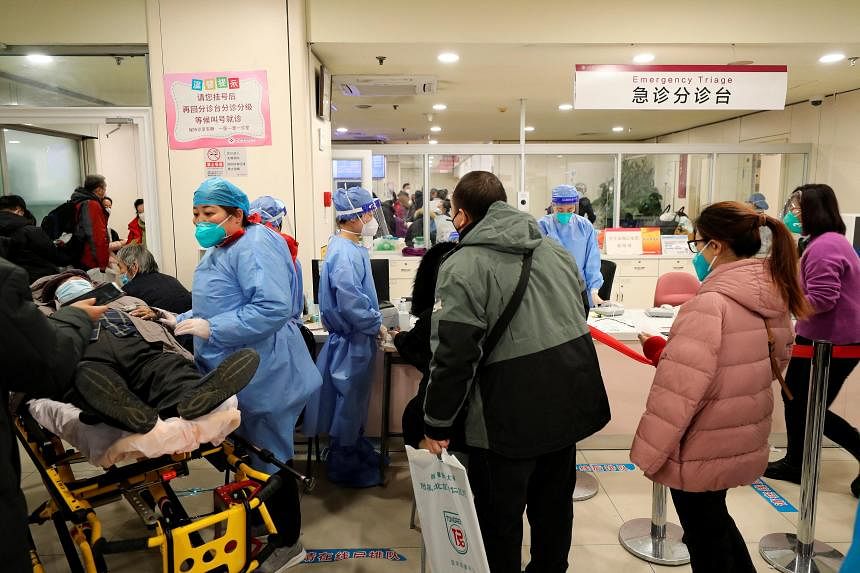
Patients at a hospital in Beijing on Dec 27. Experts here say there is a high chance of new sub-variants emerging in China. PHOTO: REUTERS

Salma Khalik
Senior Health Correspondent
Dec 29, 2022
SINGAPORE - The latest data out of China shows no new Covid-19 variant has emerged in spite of the large number of infections spreading throughout the country.
A Dec 28 statement from Gisaid, a global data science initiative, confirmed no new variants have yet emerged from the current outbreak in China.
It has been tracking and sharing changes in the coronavirus causing the Covid-19 pandemic, and has sequenced 14.4 million genomes from 215 countries.
“The 167 genomes submitted to Gisaid in the last four days provide a snapshot of the evolution of the Omicron variants and show that these most recently shared sequences from China are closely related to variants that have been circulating for some time,” said Gisaid.
Gisaid’s chief executive, Mr Peter Bogner, told The Straits Times: “It is encouraging to see the submitted genome sequence data coming from a range of provinces and time periods, adding to a representative snapshot of the variants currently circulating in China.”
The analysis was done in Singapore at A*Star’s Bioinformatics Institute (BII).
Associate Professor Hsu Liyang, an infectious diseases expert at the NUS Saw Swee Hock School of Public Health, said 167 genomes from China “is too few, but more genomes might not yield different insights other than giving a clearer picture of which variants are circulating in which parts of China”.
But senior infectious diseases consultant Professor Paul Tambyah from the National University Hospital (NUH) felt they were somewhat reassuring.
He said: “It tells us that the current reported surge of cases in China is mainly due to strains which have been circulating in the rest of the world for the last few months without a major impact on the healthcare systems of any of the countries where they have been circulating.”
Experts here say there is a high chance of new sub-variants emerging in China given the large number of people getting infected. They also noted that it is not likely to matter.
Dr Sebastian Maurer-Stroh, executive director of the BII, said: “Over the past three years, hundreds of short-lived variants have emerged with very little impact from the majority.”
He said the recent genomes from China are mostly the BA.5.2 and the BF.7, which fit the Asian pattern generally. “With global travel resuming, a more broadly synced lineage pattern would be expected,” he added.
Said Prof Hsu: “We would expect new variants globally as a matter of course. China with millions of people getting infected daily will add to the likelihood of such new variants and sub-variants arising, but should not be singled out as the sole or even the greatest risk of such an event.”
Prof Tambyah said: “There has not been a bona fide new variant since the Omicron variant emerged from South Africa (which has a considerably smaller population than China).
“The sub-variants of the Omicron variant have emerged from South Asia and other parts of the world, but none have been associated with surges of deaths even though there have been more infections.”
Some countries, such as the United States, India, Japan and Italy, have introduced health measures such as requiring Covid-19 tests, for visitors from China, fearing they could bring a new wave of infections to their shores.
Singapore has not done so, and that is the wisest course, said the experts.
Said Prof Hsu: “Singapore’s approach is rational. Taking a stricter stance against incoming travellers has done little more than briefly delay any potential new wave of Covid-19.”
Associate Professor Alex Cook, vice-dean of research at the NUS Saw Swee Hock School of Public Health, agreed: “Even if we have hundreds of infections from travellers from China a day, that is still very small compared to the number of local cases in previous waves.
“Once community transmission has already become widespread, the benefits of maintaining an isolationist policy are much reduced. Similarly, the countries rushing to erect barriers to Chinese travellers despite having had massive waves themselves of similar variants are most likely being unduly cautious.”
Professor Dale Fisher, a senior infectious diseases consultant at NUH, added: “Restricting visitors will appeal to some countries and some people, but while it may lessen a likely surge in mild cases here, I would not expect any surge to translate to many severe cases or a threatened healthcare system.”
He said there must be benefits from intervention. Implementing measures against travellers from China is both inconvenient and expensive, and will deter travel that in turn would prolong the impact on certain businesses.
“It’s very likely countries with large numbers of tourists from China will see a surge in cases to some degree,” Prof Fisher said, but for Singapore, “the high vaccination and booster rate together with the commonness of past infection makes local residents very resilient to severe disease”.
Prof Hsu added that vaccines remain effective at preventing severe diseases and deaths “with incremental efficacy, especially among the elderly, if at least one booster dose has been received”.
Today, 82 per cent of Singapore’s population has minimum vaccine protection, which means they have had at least three doses of an mRNA or Novavax vaccine or four doses of Sinovac vaccine.
Prof Cook said vaccination and prior infection can substantially reduce the severity of infections. “That is why the case fatality rate is about two in 10,000 infections over the past 28 days, which is exceptionally low even though we’re likely formally diagnosing a smaller fraction of infections than ever.”
But Prof Fisher felt it is important for “extra efforts in genomic surveillance in China and in all countries with capacity. We should only accept vaccinated travellers with necessary boosters.”
Mr Bogner, who feels the same way, said: “The need for consistency in genomic surveillance is key to avoid us flying blind.
“This need is certainly not limited to China but essential for many other countries where we would like to see a more consistent and representative genomic surveillance take place, not only for respiratory viruses but also climate-amplified diseases.”
Will a China Covid-19 wave set back endemic living in Singapore?
Despite immense efforts to strengthen the healthcare system, Singapore is not immune to future waves and should be careful not to clam up each time one approaches.
Khoo Yoong Khean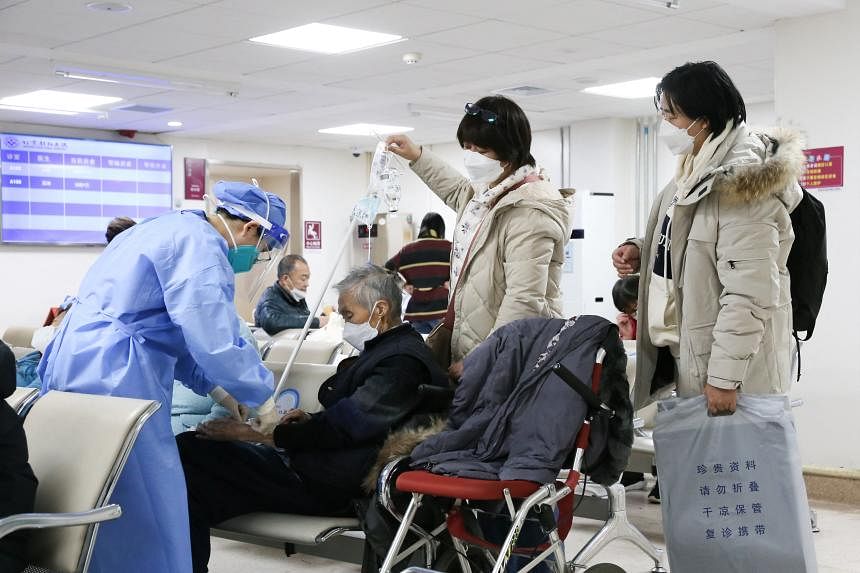
A medical worker administers an IV drip treatment for a patient at the fever clinic of Beijing Chaoyang hospital on Dec 27, 2022. PHOTO: REUTERS
Dec 30, 2022
Just when the world has made progress in understanding and managing Covid-19, with the World Health Organisation (WHO) even hoping it would no longer be a global health emergency by 2023, a spanner has been thrown into these shifting gears.
China, the world’s most populous country and last one standing in holding fast to an indefinite zero-Covid strategy of suppression, announced it would lift several pandemic restrictions two weeks ago. It has since allowed people with mild symptoms to rest at home instead of requiring quarantine at a dedicated facility, reduced public testing and removed QR codes previously needed to enter public places.
And just like every other country that relaxed its rules, these sweeping moves have expectedly led to surges in infections, with one million daily cases estimated alone in the Zhejiang province.
With 1.4 billion people, China’s healthcare system will be tested in the coming months. China’s National Health Commission (NHC) has since stopped publishing daily Covid-19 data, announcing that the China Centre for Disease Control and Prevention will only publish relevant information for reference and research. As we will not know the number of new daily infections going forward, it will be hard to ascertain the true burden of the disease.
But given the nature of the virus and our highly globalised world, China’s high-impact decision could affect many parts of the world.
Will Singapore change its measures?
Outside China, it has been a patchy and bumpy ride since 2020. Many nations have bought time during the 2020 lockdowns to fast-track vaccine development and procurement, shore up healthcare capacities and sensitise populations to the need for mitigating measures to be imposed from time to time.Through a careful, phased approach, Singapore has navigated the pandemic with relatively minimal damage, emerging with one of the lowest mortality rates in the world from Covid-19 in September 2022. Omicron and its variants swept through the population over the past year, but the number of severe cases of infections has stayed low and our healthcare capacity remains protected.
Life has gradually returned to some semblance of pre-Covid-19 normalcy, with most mask mandates lifted and vaccination-differentiated measures removed. But is Singapore truly out of the woods? Or should we sound the alarm given the potential impact of the situation in China?
And most importantly, how prepared are we to face a potential new wave of infection?
Singapore’s healthcare system shored up
Since 2020, we have taken advantage of each trough in the epidemiological waves of Covid-19 to strengthen our healthcare system, including general wards and intensive care units.During the height of the pandemic, Singapore further expanded healthcare capacities by repurposing sites like the Singapore Expo and the F1 Pit Building at Marina Bay as community care facilities. Facilities like these supported up to 4,500 beds in total.
The development of Covid-19 vaccines was arguably the turning point in the pandemic. While the vaccines have been proven to be very safe and effective, constraints on global manufacturing capacity saw the rise of issues around accessibility and equity, with high-income countries accumulating a high number of doses early in the pandemic and leaving many other countries struggling to purchase them.
In the past two years, five pharmaceutical companies have committed to setting up vaccine manufacturing plants in Singapore, capable of producing one billion doses annually. Having these facilities will enable Singapore and neighbouring countries in the region to access vaccines much faster in the future.
The key limiting factor remains healthcare human resources, for which we must press on with investments and efforts to reduce growing attrition. They are the spine of our healthcare system and have gone above the call of duty to care for us.
Notwithstanding pay hikes of 5 per cent to 14 per cent for more than 56,000 healthcare workers, the global demand for doctors, nurses and allied health professionals has swelled since the pandemic began and competition for this scarce resource remains stiff.
Other strategies Singapore has implemented will supplement the healthcare workforce, including redeploying underemployed manpower elsewhere to serve as healthcare assistants, recruiting volunteers from SG Healthcare Corps and collaborating with private hospitals.
But the healthcare workforce is situated within a dynamic and changing landscape. Cost of living, distance from families and mental health issues such as burnout are some factors determining whether people stay or leave. Apart from reviewing remuneration and redistributing manpower, other measures to keep the attrition rate low are to continually provide opportunities for career progression to encourage more to permanently relocate here. Outreach services such as counselling and peer support programmes could shore up morale and provide mental health support.
Managing risks at national and individual levels
Should Singapore close up or implement new restrictions in view of the worrying situation in China?Compared with past waves, including those involving the Delta and Omicron variants, Singapore’s potential response to any future surge has also been strengthened owing to the incredible progress in the science around Covid-19.
The availability and uptake of vaccines have heightened population immunity, shielding us from severe illness and death. Extending vaccine coverage to children aged below five and, recently, rolling out the updated bivalent Covid-19 boosters have gone some way to offer stronger protections, especially against new variants with some immune evasive properties to the previous vaccines.
Constant reminders for people to keep up with booster shots have ensured that 82 per cent of the population have minimal protections and 62 per cent have up-to-date vaccinations. Post-infection immunity also plays a part in building up our collective immunity.
S’poreans in China cheer lifting of zero-Covid curbs even as they keep an eye on rising infections
More Covid-19 infections and new wave expected with year-end travel, festivities: Ong Ye Kung
However, we know immunity levels wane naturally over time and our current level of coverage may not be enough, especially if there is a sudden spike in infection numbers. A high level of virus circulation among the population could overcome our population’s immunity if our vaccination coverage is not continually updated, which is why it is important for us to go for our booster shots.
Understanding the mechanics of transmission has allowed us to develop a robust testing strategy to close down infection clusters – including the dissemination of antigen rapid test kits to households, the decentralisation of polymerase chain reaction testing at many general practitioners’ clinics and pre-emptive sewage testing.
Masking, while not mandated in most settings now, remains highly used in Singapore with individuals exercising personal responsibility and has proven to be a simple and effective method of mitigating spread. Wearing masks in crowded spaces or if we are always in contact with the vulnerable population such as the elderly, the immunocompromised and children can help to protect them.
If necessary, public health interventions such as targeted testing and mandatory masking can be easily rolled out again in response to future health risks. In short, we have a toolkit of interventions we can pick and choose from if the situation changes.
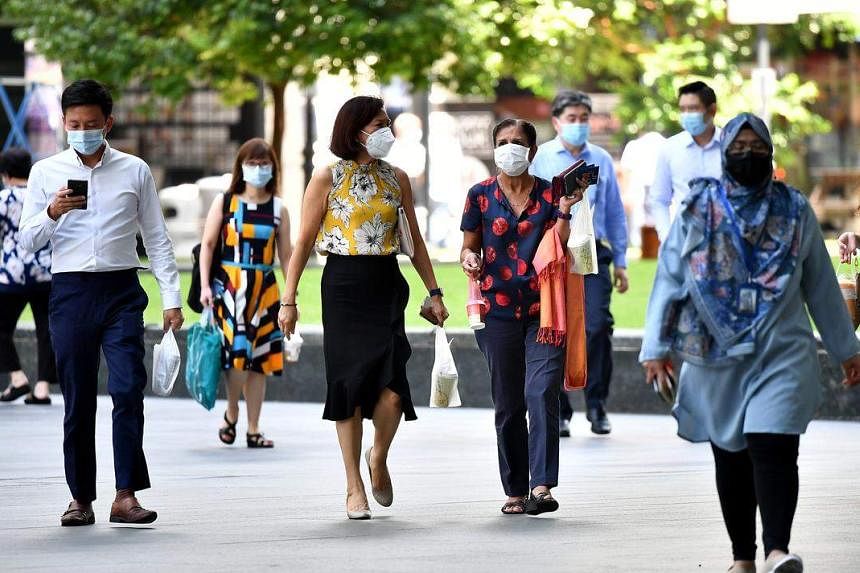
The availability and uptake of vaccines have heightened population immunity, shielding people in Singapore from severe illness and death. PHOTO: ST FILE
As more people return to offices, smart investments like improving ventilation can stem virus transmission. Simple measures such as keeping operable windows and doors open and installing exhaust fans will increase air circulation.
In air-conditioned spaces, ventilation systems and filters should be continually cleaned and maintained. Portable high-efficiency particulate air filtration systems placed in high-risk areas such as meeting rooms or office pantries can help to decrease the risk of transmission. As a standard, it would be useful for all enclosed spaces to employ particulate matter and CO2 sensors to measure air quality and ventilation.
Maintaining flexible work arrangements and allowing hybrid work, while seen primarily through employee welfare lenses, can help our workforce cope with a surge in infection.
A balancing act
Moving into the fourth year since the first Covid-19 outbreak, there is a balance we must strike between avoiding being alarmist, responding to every change in the situation and upkeeping caution, remaining ready to adapt and apply necessary measures only when needed.This balance is never easy to strike. Decisions to impose public health interventions such as mandatory masking, crowd control and vaccination-differentiated measures will require a deep understanding of the evolving science, human behaviour and national trade-offs, as well as clear communication and transparency to preserve public trust.
This highlights the need to remain constantly vigilant and make decisions after carefully considering all the aspects of the pandemic. In the end, while many decisions are on an individual level, we must consider others in our actions to protect our community and population.
Still, the evolving situation in China once again demonstrates our interconnectedness in a globalised economy where local events can have a ripple effect globally. In Singapore, one such example of its effects is how more people are purchasing over-the-counter medicine in view of the outbreak there.
More recently, as news that more flights from Beijing to Singapore will be launched by Singapore Airlines, many Singaporeans are wondering what the implications are for Singapore and how Singapore could deal with a surge in cases.
The introduction of infection through cross-border travel and the potential emergence of new variants are some of the risks we face. Health Minister Ong Ye Kung cautioned in early December that the holiday period and increased travelling will lead to a surge in infections.
Surges in infection are inevitable, given the location of Singapore as an international hub, receiving travellers either for trade or tourism. However, we can mitigate the risk by continuing to monitor developments overseas and be steadfast in the knowledge that a surge in infections isn’t anything Singapore hasn’t weathered before, and we have a toolbox of measures and strategies that can be implemented if the situation develops enough to warrant this.
Implementing targeted pre-departure and arrival Covid-19 tests for inbound travellers if the risk of a sudden influx of Covid-19 positive patients is determined to be too high is one such example.
Countries cannot live in a bubble forever and close ourselves off each time there is a huge Covid-19 outbreak elsewhere around the world. This is where continual investments in new technology and interventions such as novel diagnostics, therapeutics and vaccines will improve health security, not only in Singapore but also in the region and globally.
The situation in China will continue to evolve and depending on what transpires, we will have to adjust our response accordingly. Border closures are the first knee-jerk reaction many countries respond with to prevent the introduction of infection, but it will only delay this.
Closures also represent a nationalistic approach to a virus that does not care for nations and borders. The world is in this together as one and only by working collaboratively do we stand a chance against the relentless march of the virus.
- Dr Khoo Yoong Khean is scientific officer at the Duke-NUS Centre for Outbreak Preparedness.
Travel curbs over China’s Covid-19 surge ‘understandable’, says WHO head
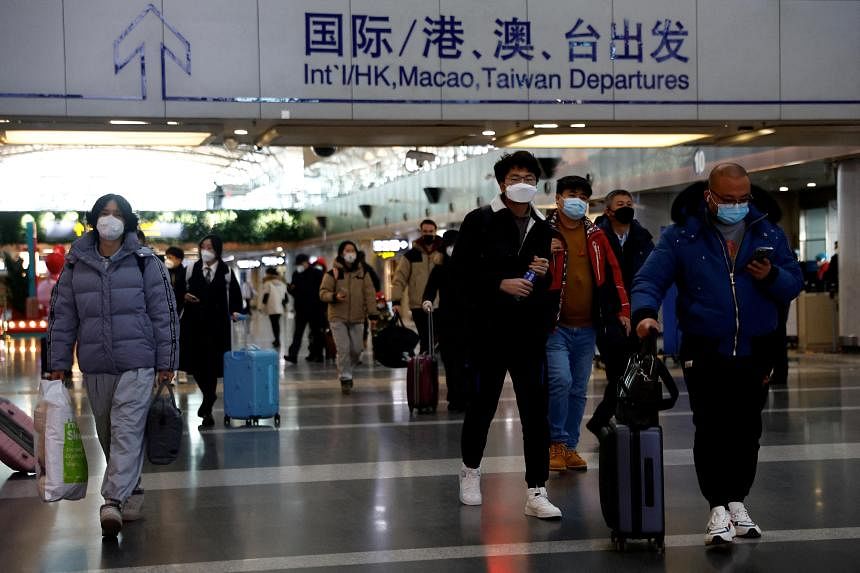
Travellers at the Beijing Capital International Airport, amid the Covid-19 outbreak in Beijing, on Dec 27, 2022. PHOTO: REUTERS
Dec 30, 2022
GENEVA – Restrictions that some countries have introduced in response to China’s Covid-19 surge are “understandable”, given the lack of information from Beijing, the head of the World Health Organisation (WHO) said on Thursday.
WHO chief Tedros Adhanom Ghebreyesus urged China to be more forthcoming on its pandemic situation.
His comments came as the United States joined several nations in imposing Covid–19 tests on travellers from China after Beijing dropped foreign travel curbs despite a surge in cases.
The European Union’s health agency said, however, that such measures were not warranted for the moment.
“In order to make a comprehensive risk assessment of the Covid-19 situation on the ground in China, WHO needs more detailed information,” Dr Tedros said on Twitter.
“In the absence of comprehensive information from China, it is understandable that countries around the world are acting in ways that they believe may protect their populations.
“We remain concerned about the evolving situation, and we continue encouraging China to track the Covid-19 virus and vaccinate the highest risk people.
“We continue to offer our support for clinical care and protecting its health system,” he said.
Hospitals across China have been overwhelmed by an explosion of infections following Beijing’s decision to lift strict rules that largely kept the virus at bay but tanked the economy and sparked widespread protests.
China said this week it would end mandatory quarantine on arrival, prompting many Chinese to make plans to travel abroad.
On Dec 21, Dr Tedros told journalists the WHO was concerned about increasing reports of severe diseases in China.
He called for detailed data on disease severity, hospital admissions and intensive care requirements.
China’s National Health Commission said last week it would no longer release an official daily Covid-19 death toll. AFP
Deleted
ccp and tiongs only have themselves to blame for being so xia xuay.
The fake news merchants are not mentioning the overwhelming of the crematorium and funeral services infrastructure. 
The truth is on Twitter, easily found if you know how to search with Chinese words.
BBQ'ing of corpses outdoors, because the crematoriums have no more vacancies:

The truth is on Twitter, easily found if you know how to search with Chinese words.

BBQ'ing of corpses outdoors, because the crematoriums have no more vacancies:
How bad is China’s Covid-19 outbreak? It’s a scientific guessing game
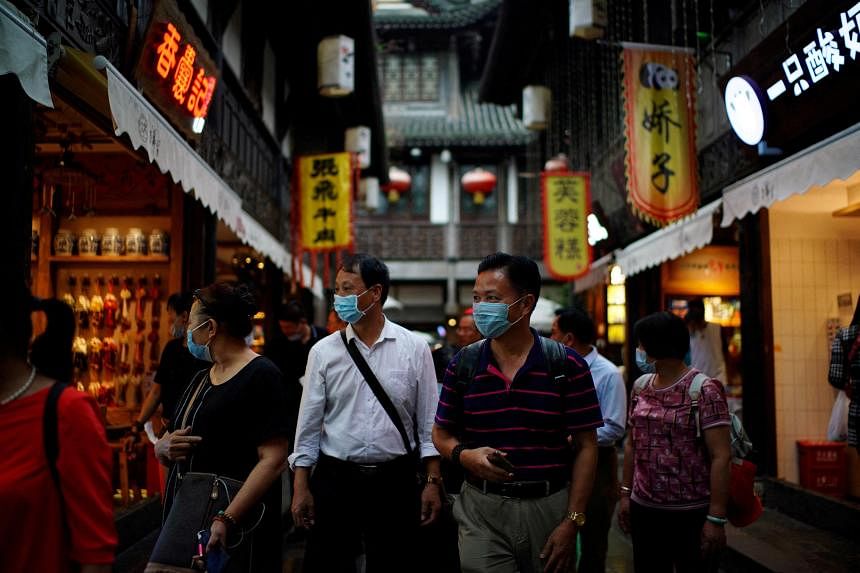
An analytics firm in Britain estimates that China could see some 1.7 million Covid-19 deaths by end-April. PHOTO: REUTERS
Dec 30, 2022
HONG KONG – As Covid-19 barrels through China, scientists around the world are searching for clues about an outbreak with sprawling consequences – for the health of hundreds of millions of Chinese people, the global economy and the future of the pandemic.
But in the absence of credible information from the Chinese government, it is a big scientific guessing game to determine the size and severity of the surge in the world’s most populous country.
In Hong Kong, one team of researchers pored over passenger data from five Beijing subway lines to determine the potential spread.
In Seattle, a group of modellers tried in vain to reverse-engineer an unverified government leak detailing case numbers from Chinese health officials.
In Britain, scientists are coming up with their own efficacy estimates of Chinese vaccines.
Any personal anecdote or social media report from China – scarce medicines, overrun hospitals, overflowing crematories – is possible fodder for researchers’ models.
They are all attempting to understand the same things: How quickly is the virus spreading in China? How many people are dying? Could China be the source of a new and dangerous variant?
As scientists sift through varied sources of shaky information, they are bracing for potentially catastrophic outcomes.
Barring new precautionary steps, some worst-case estimates suggest that Covid-19 could kill as many people in China in the next four months as it has Americans during the entire three-year pandemic.
Without satisfying answers, some countries are putting limits on Chinese travellers, albeit based in part on unfounded fears or political motivations.
The United States, Italy and Japan have said they will require a negative Covid-19 test for those coming from China, citing concerns that the surge in cases in China could produce new, more threatening variants.
While researchers and virus experts said the new measures would most likely do little, if anything, to blunt the spread, the policies reflect the limited visibility into the outbreak.
‘Nobody has a clue’
Scientists’ models generally point to an explosive spread and a high death rate, given how many people in China have little to no immunity to Omicron subvariants. But even their estimates are all over the place.In the bleakest of several scenarios of what the end of China’s zero-Covid policy might mean, nearly 1 million people could die during the early months of reopening, Hong Kong researchers reported in December in a study partly funded by the Chinese Centre for Disease Control and Prevention, though the study does not provide an exact time period.
An American group estimated as many as half a million deaths by April and another 1 million by the end of 2023 if China rejects social-distancing mandates.
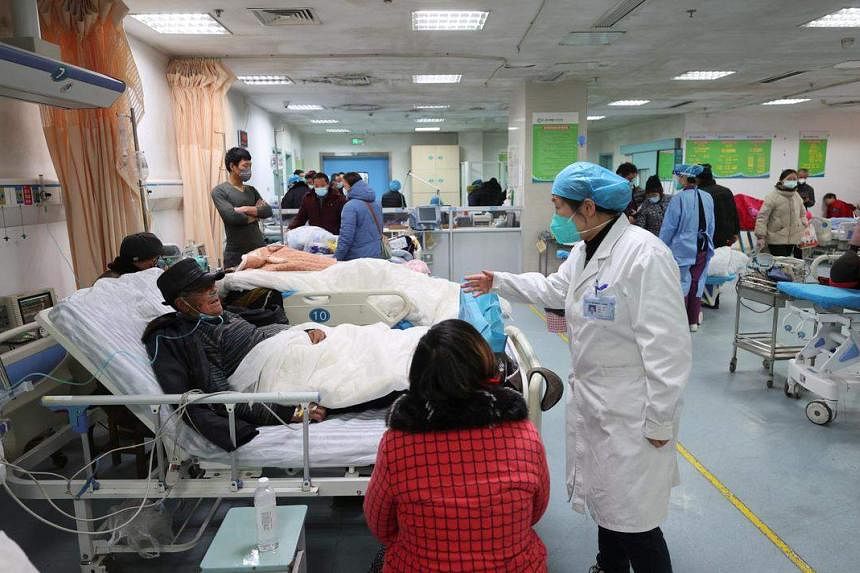
The emergency department of Ganyu District People’s Hospital, amid the Covid-19 outbreak in Lianyungang, Jiangsu, on Dec 28. PHOTO: REUTERS
Airfinity, a Britain-based analytics company, this week offered an even more dire short-term forecast: 1.7 million Covid-19 deaths by the end of April.
Until December, the world seemed to have a reasonably clear understanding of what was happening with the virus in China. The ruling Communist Party proudly published low daily case numbers and deaths as a testament to its stringent zero-Covid policy. A countrywide system of lockdowns, quarantines and mass testing largely kept the virus at bay.
But in early December, the government abruptly abandoned zero-Covid, leaving the scientific community largely in the dark.
“Nobody, nobody has a clue,” said Dr Siddharth Sridhar, a clinical virologist with a focus on emerging infectious diseases.
Many more may needlessly die
Officially, China has claimed just 12 deaths from Covid-19 since Dec 1. The country has said it will only count those who die from respiratory failure directly linked to an infection, leaving out vast numbers who died because Covid-19 aggravated underlying diseases or caused heart or liver failure.Experts say the sheer speed of the spread would suggest a much higher number of deaths.
There are also indications that officials are pressuring doctors and crematories to avoid categorising even respiratory deaths as virus related.
Several modellers have even been sceptical of leaked information from government officials on case counts, which have been used to assess the scale of China’s outbreak.
One recent estimate, making the rounds in news reports and on Chinese social media, cited data from national health officials that 250 million people had been infected in the first 20 days of December.
Some scientists said such massive figures indicated either that China has been suppressing data for months or that it is trying to make it seem like the outbreak has peaked.
“Either they know something we don’t, or they’re trying to say the worst is already over,” said Dr Christopher Murray, director of the Institute for Health Metrics and Evaluation at the University of Washington. NYTIMES
Similar threads
- Replies
- 1
- Views
- 325
- Replies
- 18
- Views
- 1K
- Replies
- 6
- Views
- 654
- Replies
- 2
- Views
- 317
- Replies
- 6
- Views
- 805
